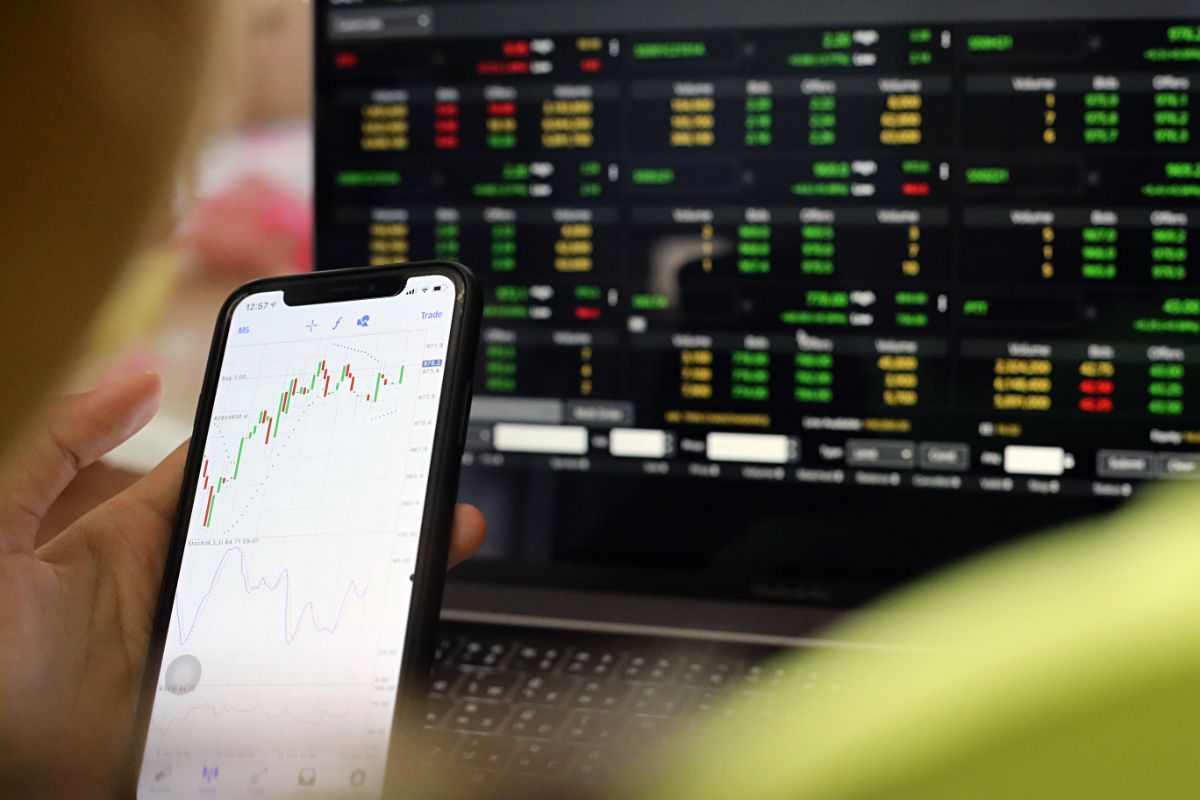If you’ve got an itch to try trading stocks online, it can seem overwhelming to see the graphs and sprawling bits of information passing you by quickly. And that’s not to mention complicated strategies, commissions, and portfolios. How do you make sense of it all? Stock Average Calculator app is all you need.
Average Cost Calculator
Stock Average Down Calculator Results

You can get set up on trading platforms, and you can do your research and follow the data, but you may find yourself trying to keep tabs on various stocks and trying to work out your average cost per share.
An average stock calculator can be helpful here if you want to keep costs down or you want to track the progress of a stock over an accounting period.
This guide will describe what an average stock calculator does, make sense of averaging up or down, and which ones are available. If you’re still confused and can’t get your head around these terms, then read on.
What Is An Average Stock Calculator?
The average stock calculator is an application that calculates the average cost of your stocks when you purchase the same stock multiple times.
Note here that multiple times doesn’t necessarily mean all at once, but rather if you are to buy shares that go up or down in price.
The average down calculator will give you the average cost for average down or average up. To get your cost average as accurate as possible, you want to enter each transaction separately.
Put simply, if you buy a share when it dips, and the dip continues to fall, and you buy more, you would want to know how much you paid per share in the end.
Or, put more simply, you would want to know the cost basis of your stocks. A stock average calculator can tell you the exact value per share, regardless of how many prices you may have bought at.
Below we have provided explanations for some terms you may come across and how to use this information for investing when using stock calculators (see also ‘How To Calculate Gross Investment‘).
The Stock Profit
The stock profit, or the cost basis of a stock, is the average stock price you get after buying shares of one company at different prices.
This can be easygoing if you’ve bought multiple shares of a stock at a single price. You can calculate the stock profit by taking the market value and subtracting it from what you’ve invested.
Sounds simple so far, but what if you were to buy, let’s say, a share in Block Inc at $85, and each successive day you spend $5 less for six days.
So on the sixth day, you are down to $60. If we add in the factor that the Block Inc stock could go up to something like $100, it gets a little more complicated.
To work this out, you’ll have to work out the average stock price. Below is a working example of how to make this calculation.
Working Out The Average Stock Price
If you use the example above, all you need to do is add up all the amounts you’ve paid for the stock and divide this by the total number of shares you bought. An example would be something like this:
85 + 80+ 75 + 70 + 65 + 60 = 435.
Take that value of 435 and divide it by the number of shares, which is six, so you end up with an average stock price or stock cost basis of $72.50 USD.
Calculating The Stock Profit Or Loss
Now you know your average stock price, you need to perform one more calculation to determine the stock profit of the values above.
If you assume that today that the value of Block Inc sits at $100 per share, you can subtract your stock cost basis, so we can use the value of $72.50 USD from above.
Once you have that value, you need to times it by the number of shares you bought, so in this example, it would be 6, and so you should have an equation that looks like this:
100 – 72.50 = 27.5, which becomes 27.5 x 6 = 165.
So your stock profit would be $165 USD. If this looks confusing, or you have more than six shares you bought in any accounting period, there are many online calculator tools you can use online where you can enter up to ten values at any given time.
Profit Percentage
This may not apply to all traders, but some holders of multiple portfolios may want to generate the stock profit in percentage.
Bear in mind that when you do this calculation, you are using the current stock price and your stock cost basis, which in the previous example was $100 and $72.50 USD, respectively, so your calculation should look like this:

100 USD – 72.50 USD = 27.5, which you want to divide by 72.50 = 0.379.
Take the value 0.379 and times it by 100, which gives you 37.93, or 38%. Not a bad return if ever we saw it. But how do you use these numbers in reference to building some sort of strategy? Read on to find out.
How To Use Cost Basis For Investing
If you’re building up a portfolio and you’ve worked out your stock profit and your profit percentage, you may be wondering how this all relates to a strategy. These few steps are a few tips to help you get some footing and optimize your trades.
Step 1
As mentioned above, you want to calculate the cost basis or stock average price at which you have already purchased your shares.
At this point, you want to have bought multiple shares, and there isn’t any particular pattern you have to follow. You can also set limits in case there are any drastic fluctuations in your specific stock.
Step 2
This step requires you to have some knowledge of the company from which you’ve bought shares from. If you’re convinced about the performance or excellence of the company, you can build on your position by buying shares at a lower price, if possible.
This will require you to speculate on the market and any news about the company, including new products or services, which in time will build your confidence in trading, which can only be a good thing.
Step 3
Now you want to define your new cost basis, which should reflect the new cost of the stock alongside the older one if you are buying shares over an accounting period.
This helps bring everything together in one calculation, and you can work out the percentage if you want to see the profit percentage before adding any unrealized gain.
Step 4
Use the cost basis from the last step to obtain your new upside or downside, which can also account for any unrealized capital gain. In terms of trading, upsiding or downsiding is like two sides of a coin an investor must evaluate.
To say a stock has upsiding means it has the potential to increase in value, and downsizing is the opposite, as it may show issues in the exchange when comparing the two side by side.
Step 5
This step is to allow you to calculate your new dividend yield if you’ve bought a stock dividend which are shares that may be from a company’s profit, which is shared with investors.
These shares can be paid out monthly or sometimes annually, being quite lucrative if you’re certain about the company’s performance and that they have a consistent to rising profit each quarter.
What Is A Dividend Yield?
Seeing as we mentioned dividends above, the main focus of your portfolio might be stock dividends.
If you are thinking of making your start in investing in these types of stocks, you want to be wary that they vary in the price you pay for them, and the return you get back from a dividend is based on a per-share basis.
This can make them difficult to predict, but that is where the dividend yield calculator comes in handy.
This tool expresses the annual amount of how much you get back towards your original investment as a percentage, making comparisons easier. Below is a working example of calculating your dividend yield.

How To Calculate A Dividend Yield
To put it simply, the dividend yield formula is an equation that is the ratio of a company’s annual dividend to its share price. For this example, you are going to purchase a dividend stock from Lowe’s for, say, $180 USD, which we will call the share price.
Then you discover the annual dividend for Lowe’s is, let’s say, $50 USD per share, you can use the simple formula which is expressed like this:
Annual dividend, which is $50 USD divided by stock price, which is $180 USD, then simply times that value by 100, which equals 27.77%, as a more straightforward percentage.
This yield percentage can be beneficial if you get this dividend back on an annual basis, and the dividend payouts can be calculated in the same way as if you were to calculate the interest rate.
This is really useful if you decide you want to reinvest in another dividend sometime later on in the accounting period and gives that portfolio some clarity if you are wondering where to invest next.
Dividend Reinvestment Calculator
It usually is common practice to reinvest and buy even more shares from the money you get back from the dividends.
These reinvestment plans can be lucrative because when you reinvest, the dividends are compounding, meaning they are added back to the initial invested amount.
So you buy even more shares, and you will receive an even more significant amount the next time your dividend pays out because you have more shares.
This calculation can be a little confusing but fear not. We’re going to use a working example to make the process easier.
We’re trying to work out the future value of the investment, or final balance, which we are going to use $195 USD, so we can add the money invested or the initial balance, which is the value of the investment.
Here we also want the dividend yield so that we can use that 27.77% from our last example.
Now we want the number of times the dividend is compounded, so in this example, we’re going to assume that our dividend compounds quarterly, or 4 times a year. And lastly, we want to add the number of years the money is invested for, so we’re going to assume a 2-year period.
So, this looks like $195 USD = $180 USD x ( 1 + 27.77% ÷ 4) 4 x 2.
This gives us a $15 USD profit and an overall growth percentage of 8.33%. Any future dividends we receive from shares would provide us with an additional yield of 4.02%.
It can be difficult to get these values to a precise percentage, and we won’t tell anyone if you decide to use a calculator as there are a lot of values to account for here.
What Is Averaging Up Or Down?
Now you know how to work out a stock price, stock profit, dividend yield, and reinvestment, these calculations can impact how much or little of a stock you purchase.
You may have heard averaging up or down (see also ‘What Is Averaging Down In Stocks?‘) when looking at average stock prices and these terms have a significant impact on a trading strategy. Below is a breakdown of each term and an example of how each impacts a trading strategy.
Averaging Up
This term refers to when you buy more of a stock or other investment after the market price increases, so you’re averaging up. This is because the average price of your position goes up and can be very lucrative if you’re buying into an uptrend.
An example of averaging up in the stock market is let’s say that we use Block Inc from before, and you buy 100 shares for $52 USD per share.

Then for the first year and a half or so, the stock price dropped a little, going as low as $30 per share and hitting $100 per share at its highest point.
Then, let’s say that the company reported strong quarterly results. Sales were up, revenue per user was up, and active users reached into the millions. So you decided to buy 100 more shares later on at $150 per share.
This seems to be the most lucrative option because the trade is already profitable when you make the purchase and seems the most risk-averse.
Averaging Down
A more widely used term in investing which means when you buy more of a stock even though the stock price has fallen. So the opposite of averaging up. The benefit of averaging down is that you’re reducing your average price.
If the prices rise later and you’re eventually proven correct, you’ll have an even better gain than if you had just stuck with the initial investment.
The most significant risk, however, is the fact that you may be wrong about the trade or investment, and the price will continue to move against you.
This method may require more knowledge of how specific markets work, outside influences, the performance of the company, and your insight or instinct if you are willing to take risks.
Should I Average Up Or Down?
Of course, using these calculators can give you some indication of your profit or loss when looking at that return, but knowing when to average up or down can seem like guesswork to the outsider.
Before you do either, you want to make sure you have some form of knowledge regarding the company’s performance, and it may take you two, three, or even four quarters to get used to the marketplace.
You also have to consider other expenses such as capital gains taxes and commissioning fees if you are using a traditional brokerage firm.
There are tools online that can help you make these deductions, and advanced calculators may give you the return in percentage, giving you clarity when deciding where to buy next.
The Bottom Line
The above information gives some general advice on how to interpret your calculations and how they work regarding the process of trading stocks. Still, they aren’t definitive ways to build a consistent portfolio.
With some stocks changing very frequently, it would be hard to provide a tailor-made strategy to accommodate every type of trade, so it may be worth your while to consult with insiders to that particular market or consult a brokerage firm who will share your enthusiasm for the project and help you reach your goal.
Of course, it would be worth mentioning that you’re probably not going to hit the ground running if you’re new to the market, so it would be best to be realistic about your short-term goals and work your way from there.
Experience will tell you what may be going on around your stock project if you’re a budding professional or if you may want some passive income from time to time. Good luck.
- Best Gold IRA investment strategies - July 24, 2024
- Gold IRA Rollover: How to Convert Your Retirement Savings - July 24, 2024
- Understanding Gold IRA: A Comprehensive Guide to Secure Retirement - July 23, 2024
